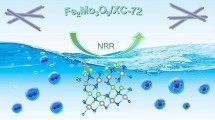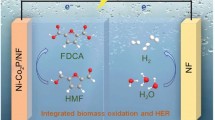Abstract
NH3, derived from electrocatalytic nitrogen reduction reaction (NRR), is promising to satisfy the need of food production and serve as a carbon-free liquid energy carrier in the near future. Yet major challenges remain in enhancing NH3 yield rate and conversion efficiency of available electrocatalysts. This work achieved an ultrahigh electrocatalytic NH3 yield rate on the 0.50Fe-Bi2WO6 catalyst by a facile Fe-doped strategy. Up to 289 µg·h−1·mgcat−1 of NH3 formation rate was obtained at −0.75 V vs. RHE, which was reliably quantized by indophenol blue and 1H NMR methods. The impressive result is an order of magnitude higher than that of the reported Fe- and Bi-based catalysts, even more superior than the result of single atom Ru catalyst. The key of the outstanding NRR behaviors on the 0.50Fe-Bi2WO6 catalyst is the significant hydrogen evolution reaction (HER) suppression and the synergy between Bi and Fe, which can effectively modulate the electron distribution and accelerate the electron transport. This work endows a new insight to further explore the high-performance electrocatalysts toward NRR.

Similar content being viewed by others
References
Wang, F.; Gerken, J. B.; Bates, D. M.; Kim, Y. J.; Stahl, S. S. Electrochemical strategy for hydrazine synthesis: Development and overpotential analysis of methods for oxidative N-N coupling of an ammonia surrogate. J. Am. Chem. Soc. 2020, 142, 12349–12356.
Kim, S.; Loose, F.; Chirik, P. J. Beyond ammonia: Nitrogen-element bond forming reactions with coordinated dinitrogen. Chem. Rev. 2020, 120, 5637–5681.
Zhang, G.; Xu, H.; Li, Y.; Xiang, C.; Ji, Q. H.; Liu, H. J.; Qu, J. H.; Li, J. H. Interfacial engineering of SeO ligands on tellurium featuring synergistic functionalities of bond activation and chemical states buffering toward electrocatalytic conversion of nitrogen to ammonia. Adv. Sci. 2019, 6, 1901627.
Fang, Y.; Xue, Y. R.; Li, Y. J.; Yu, H. D.; Hui, L.; Liu, Y. X.; Xing, C. Y.; Zhang, C.; Zhang, D. Y.; Wang, Z. Q., et al. Graphdiyne interface engineering: Highly active and selective ammonia synthesis. Angew. Chem., Int. Ed. 2020, 132, 13121–13127.
Lv, X. S.; Wei, W.; Li, F. P.; Huang, B. B.; Dai, Y. Metal-free B@g-CN: Visible/infrared light-driven single atom photocatalyst enables spontaneous dinitrogen reduction to ammonia. Nano Lett. 2019, 19, 6391–6399.
Zhao, X.; Yao, C.; Chen, H.; Fu, Y. F.; Xiang, C. J.; He, S. H.; Zhou, X. H.; Zhang, H. B. In situ nano Au triggered by a metal boron organic polymer: Efficient electrochemical N2 fixation to NH3 under ambient conditions. J. Mater. Chem. A 2019, 7, 20945–20951.
Zheng, J. Y.; Lyu, Y. H.; Qiao, M.; Veder, J. P.; Marco, R. D.; Bradley, J.; Wang, R. L.; Li, Y. F.; Huang, A. B.; Jiang, S. P. et al. Tuning the electron localization of gold enables the control of nitrogen-to-ammonia fixation. Angew. Chem., Int. Ed. 2019, 58, 18604–18609.
Deng, J.; Iñiguez, J. A.; Liu, C. Electrocatalytic nitrogen reduction at low temperature. Joule 2018, 2, 846–856.
Greenlee, L. F. Recycling fertilizer. Nat. Energy 2020, 5, 557–558.
Cui, X. Y.; Tang, C.; Zhang, Q. A review of electrocatalytic reduction of dinitrogen to ammonia under ambient conditions. Adv. Energy Mater. 2018, 8, 1800369.
Qing, G.; Ghazfar, R.; Jackowski, S. T.; Habibzadeh, F.; Ashtiani, M. M.; Chen, C. P.; Smith III, M. R.; Hamann, T. W. Recent advances and challenges of electrocatalytic N2 reduction to ammonia. Chem. Rev. 2020, 120, 5437–5516.
Hao, Q.; Liu, C. W.; Jia, G. H.; Wang, Y.; Arandiyan, H.; Wei, W.; Ni, B. J. Catalytic reduction of nitrogen to produce ammonia by bismuth-based catalysts: State of the art and future prospects. Mater. Horiz. 2020, 7, 1014–1029.
Di, J.; Xia, J. X.; Chisholm, M. F.; Zhong, J.; Chen, C.; Cao, X. Z.; Dong, F.; Chi, Z.; Chen, H. L.; Weng, Y. X. et al. Defect-tailoring mediated electron-hole separation in single-unit-cell Bi3O4Br nanosheets for boosting photocatalytic hydrogen evolution and nitrogen fixation. Adv. Mater. 2019, 31, 1807576.
Deng, P. L.; Wang, H. M.; Qi, R. J.; Zhu, J. X.; Chen, S. H.; Yang, F.; Zhou, L.; Qi, K.; Liu, H. F.; Xia, B. Y. Bismuth oxides with enhanced bismuth-oxygen structure for efficient electrochemical reduction of carbon dioxide to formate. ACS Catal. 2020, 10, 743–750.
Byun, S.; Jung, G.; Shi, Y. Y.; Lanza, M.; Shin, B. Aging of a vanadium precursor solution: Influencing material properties and photoelectrochemical water oxidation performance of solution-processed BiVO4 photoanodes. Adv. Funct. Mater. 2020, 30, 1806662.
Li, N.; Liu, J.; Dong, B. X.; Lan, Y. Q. Polyoxometalate-based compounds for photo- and electrocatalytic applications. Angew. Chem., Int. Ed. 2020, 59, 20779–20793.
Zhang, J.; Tian, X. Y.; Liu, M. J.; Guo, H.; Zhou, J. D.; Fang, Q. Y.; Liu, Z.; Wu, Q.; Lou, J. Cobalt-modulated molybdenum-dinitrogen interaction in MoS2 for catalyzing ammonia synthesis. J. Am. Chem. Soc. 2019, 141, 19269–19275.
Shi, Y.; Zhou, Y.; Yang, D. R.; Xu, W. X.; Wang, C.; Wang, F. B.; Xu, J. J.; Xia, X. H.; Chen, H. Y. Energy level engineering of MoS2 by transition-metal doping for accelerating hydrogen evolution reaction. J. Am. Chem. Soc. 2017, 139, 15479–15485.
Fang, Y. J.; Yu, X. Y.; Lou, X. W. Formation of hierarchical Cu-doped CoSe2 microboxes via sequential ion exchange for high-performance sodium-ion batteries. Adv. Mater. 2018, 30, 1706668.
Zhao, Y. X.; Zhao, Y. F.; Shi, R.; Wang, B.; Waterhouse, G. I. N.; Wu, L. Z.; Tung, C. H.; Zhang, T. R. Tuning oxygen vacancies in ultrathin TiO2 nanosheets to boost photocatalytic nitrogen fixation up to 700 nm. Adv. Mater. 2019, 31, 1806482.
Sun, H.; Min, Y. X.; Yang, W. J.; Lian, Y. B.; Lin, L. L.; Feng, K.; Deng, Z.; Chen, M. Z.; Zhong, J.; Xu, L. et al. Morphological and electronic tuning of Ni2P through iron doping toward highly efficient water splitting. ACS Catal. 2019, 9, 8882–8892.
Tong, Y. Y.; Guo, H. P.; Liu, D. L.; Yan, X.; Su, P. P.; Liang, J.; Zhou, S.; Liu, J.; Lu, G. Q.; Dou, S. X. Vacancy engineering of iron-doped W18O49 nanoreactors for low-barrier electrochemical nitrogen reduction. Angew. Chem., Int. Ed. 2020, 59, 7356–7361.
Meng, Q. Q.; Lv, C. D.; Sun, J. X.; Hong, W. Z.; Xing, W. N.; Qiang, L. S.; Chen, G.; Jin, X. L. High-efficiency Fe-mediated Bi2MoO6 nitrogen-fixing photocatalyst: Reduced surface work function and ameliorated surface reaction. Appl. Catal., B 2019, 256, 117781.
Suryanto, B. H. R.; Kang, C. S. M.; Wang, D.; Xiao, C. L.; Zhou, F. L.; Azofra, L. M.; Cavallo, L.; Zhang, X. Y.; MacFarlane, D. R. Rational electrode-electrolyte design for efficient ammonia electrosynthesis under ambient conditions. ACS Energy Lett. 2018, 3, 1219–1224.
Lazouski, N.; Schiffer, Z. J.; Williams, K.; Manthiram, K. Understanding continuous lithium-mediated electrochemical nitrogen reduction. Joule 2019, 3, 1127–1139.
Chen, G. F.; Ren, S. Y.; Zhang, L. L.; Cheng, H.; Luo, Y. R.; Zhu, K. H.; Ding, L. X.; Wang, H. H. Advances in electrocatalytic N2 reduction—strategies to tackle the selectivity challenge. Small Methods 2019, 3, 1800337.
Andersen, S. Z.; Čolić, V.; Yang, S.; Schwalbe, J. A.; Nielander, A. C.; McEnaney, J. M.; Enemark-Rasmussen, K.; Baker, J. G.; Singh, A. R.; Rohr, B. A. et al. A rigorous electrochemical ammonia synthesis protocol with quantitative isotope measurements. Nature 2019, 570, 504–508.
Tang, C.; Qiao, S. Z. How to explore ambient electrocatalytic nitrogen reduction reliably and insightfully. Chem. Soc. Rev. 2019, 48, 3166–3180.
Suryanto, B. H. R.; Du, H. L.; Wang, D. B.; Chen, J.; Simonov, A. N.; MacFarlane, D. R. Challenges and prospects in the catalysis of electroreduction of nitrogen to ammonia. Nat. Catal. 2019, 2, 290–296.
Wang, Y. N.; Zhang, S. L.; Zhong, Q.; Zeng, Y. Q.; Ou, M.; Cai, W. Hydrothermal synthesis of novel uniform nanooctahedral Bi3(FeO4)(WO4)2 solid oxide and visible-light photocatalytic performance. Ind. Eng. Chem. Res. 2016, 55, 12539–12546.
Cheng, H.; Cui, P. X.; Wang, F. R.; Ding, L. X.; Wang, H. H. High efficiency electrochemical nitrogen fixation achieved with a lower pressure reaction system by changing the chemical equilibrium. Angew. Chem., Int. Ed. 2019, 58, 15541–15547.
Chen, X. R.; Guo, Y. T.; Du, X. C.; Zeng, Y. S.; Chu, J. W.; Gong, C. H.; Huang, J. W.; Fan, C.; Wang, X. F.; Xiong, J. Atomic structure modification for electrochemical nitrogen reduction to ammonia. Adv. Energy Mater. 2020, 10, 1903172.
Zhao, Y. X.; Shi, R.; Bian, X. A.; Zhou, C.; Zhao, Y. F.; Zhang, S.; Wu, F.; Waterhouse, G. I. N.; Wu, L. Z.; Tung, C. H., et al. Ammonia detection methods in photocatalytic and electrocatalytic experiments: How to improve the reliability of NH3 production rates?. Adv. Sci. 2019, 6, 1802109.
Yang, X.; Kattel, S.; Nash, J.; Chang, X. X.; Lee, J. H.; Yan, Y. S.; Chen, J. G.; Xu, B. J. Quantification of active sites and elucidation of the reaction mechanism of the electrochemical nitrogen reduction reaction on vanadium nitride. Angew. Chem., Int. Ed. 2019, 58, 13768–13772.
Wang, J.; Huang, B. L.; Ji, Y. J.; Sun, M. Z.; Wu, T.; Yin, R. G.; Zhu, X.; Li, Y. Y.; Shao, Q.; Huang, X. Q. A general strategy to glassy M-Te (M = Ru, Rh, Ir) porous nanorods for efficient electrochemical N2 fixation. Adv. Mater. 2020, 32, 1907112.
Watt, G. W.; Chrisp, J. D. Spectrophotometric method for determination of hydrazine. Anal. Chem. 1952, 24, 2006–2008.
Geng, Z. G.; Liu, Y.; Kong, X. D.; Li, P.; Li, K.; Liu, Z. Y.; Du, J. J.; Shu, M.; Si, R.; Zeng, J. Achieving a record-high yield rate of 120.9 µgNH3mgcat−1h−1 for N2 electrochemical reduction over Ru single-atom catalysts. Adv. Mater. 2018, 30, e1803498.
Yao, Y.; Zhu, S. Q.; Wang, H. J.; Li, H.; Shao, M. H. A spectroscopic study on the nitrogen electrochemical reduction reaction on gold and platinum surfaces. J. Am. Chem. Soc. 2018, 140, 1496–1501.
Li, Y.; Wang, H. H.; Priest, C.; Li, S. W.; Xu, P.; Wu, G. Advanced electrocatalysis for energy and environmental sustainability via water and nitrogen reactions. Adv. Mater., in press, DOI: https://doi.org/10.1002/adma.202000381.
Gao, X.; An, L.; Qu, D.; Jiang, W. S.; Chai, Y. X.; Sun, S. R.; Liu, X. Y.; Sun, Z. C. Enhanced photocatalytic N2 fixation by promoting N2 adsorption with a co-catalyst. Sci. Bull. 2019, 64, 918–925.
Feng, J. X.; Pan, H. Electronic state optimization for electrochemical N2 reduction reaction in aqueous solution. J. Mater. Chem. A 2020, 8, 13896–13915.
Acknowledgements
This work is supported by the National Natural Science Foundation of China (Nos. 21675151, 21705145 and 21721003), and the Ministry of Science and Technology of China (No. 2016YFA0203203). (further details of the experimental section, corresponding calibration curves, control experiment, electrochemical measurement of contrast materials, N2H4 determination, EIS, SEM, TEM, XRD, XPS characterization, and so on) is available in the online version of this article at https://doi.org/10.1007/s12274-020-3276-9.
Author information
Authors and Affiliations
Corresponding author
Electronic Supplementary Material
Rights and permissions
About this article
Cite this article
Liu, Y., Huang, L., Fang, Y. et al. Achieving ultrahigh electrocatalytic NH3 yield rate on Fe-doped Bi2WO6 electrocatalyst. Nano Res. 14, 2711–2716 (2021). https://doi.org/10.1007/s12274-020-3276-9
Received:
Revised:
Accepted:
Published:
Issue Date:
DOI: https://doi.org/10.1007/s12274-020-3276-9




